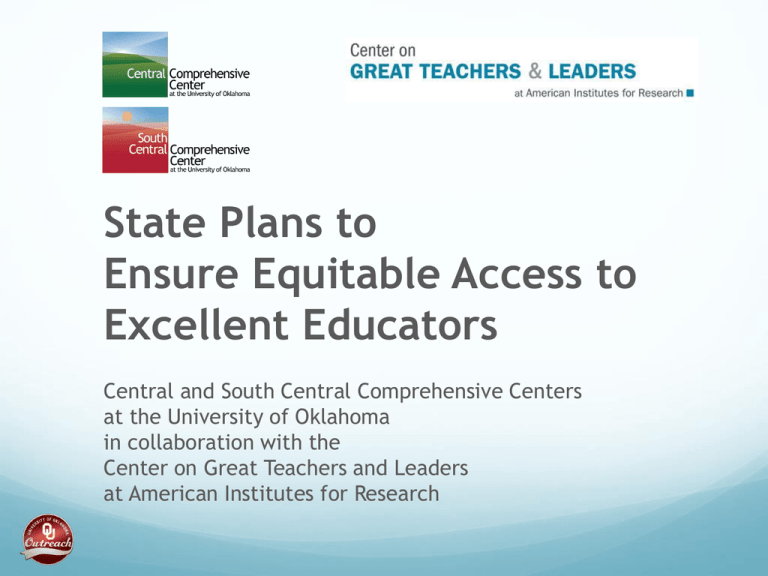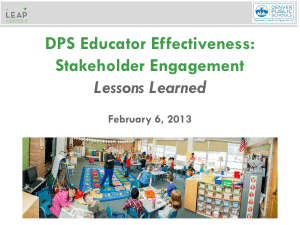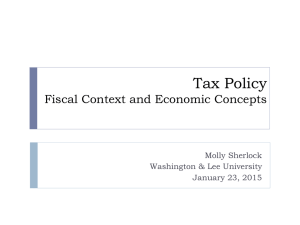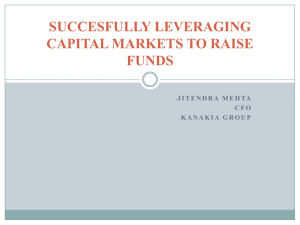
State Plans to
Ensure Equitable Access to
Excellent Educators
Central and South Central Comprehensive Centers
at the University of Oklahoma
in collaboration with the
Center on Great Teachers and Leaders
at American Institutes for Research
Welcome and Introductions
Sarah Hall
SC3 Associate Director and New Mexico/Oklahoma
Technical Assistance Coordinator
State Plans to Ensure
Equitable Access to
Excellent Educators—
Webinar 1
December 18, 2014
Ellen Sherratt, Ph.D.
Copyright © 2014 American Institutes for Research. All rights reserved.
Webinar Overview
This webinar will provide an overview of the following:
• Requirements and recommendations of the contents to include in State
Plans to Ensure Equitable Access to Excellent Educators
• Resources available to support the development of plans
• Key challenge areas states may face
• Highlights from Missouri’s equitable access planning process
4
Excellent Educators for All
Requirements
The six requirements in the federal FAQ guidance:
• Describe and provide documentation of the steps taken by the state education
agency (SEA) to consult stakeholders.
• Identify equity gaps and explain the calculations and the process of identification.
• Explain the likely cause(s) of the identified equity gaps. (For example, an SEA
might conduct a root-cause analysis.)
• Set forth the SEA’s steps to eliminate identified equity gaps (strategies, timelines
for implementation, and mechanisms for monitoring).
• Describe the measures that the SEA will use to evaluate progress toward
eliminating the identified equity gaps, including the method and timeline.
• Describe how the SEA will publicly report on its progress in eliminating the
identified gaps, including timelines for this reporting.
5
Excellent Educators for All Supports
Several supports are available, including:
• Data profiles from the U.S. Department of Education
• New Equitable Access Support Network
• Center on Great Teachers and Leaders Overview Webinar:
http://www.gtlcenter.org/products-resources/ensuring-equitable-accessgreat-teachers-and-leaders
• Center on Great Teachers and Leaders Equitable Access Toolkit:
http://www.gtlcenter.org/learning-hub/equitable-access-toolkit
6
Stakeholder Engagement
Important information about engaging stakeholders:
• Engage stakeholders early.
• Provide multiple opportunities for meaningful input.
• Engage a broad range of stakeholders, including not only teachers,
principals, districts, and parents but also civil rights organizations, students
with disabilities and English learner groups, businesses, Native American
tribal groups, local boards of education, higher education, and human
resources directors.
7
Stakeholder Engagement
Stakeholder engagement resources include:
• Stakeholder engagement guide and 12 supplementary resources:
http://www.gtlcenter.org/learning-hub/equitable-access-toolkit/stakeholderengagement-guide
– Includes step-by-step guidance, sample timelines and meeting agendas, communications and
messaging tips, discussion protocols and activities, a sample kickoff slide presentation, and
steps for translating the material into a statewide guide for local education agencies (LEAs)
– Includes suggestions for creating a long-term educator equity coalition of stakeholders
• Summary stakeholder engagement guide document and an online
interactive tool (coming soon!)
Key challenge area = capacity
• Solutions?
8
Stakeholder Engagement
Stakeholder engagement resources include:
• Stakeholder engagement guide and 12 supplementary resources:
http://www.gtlcenter.org/learning-hub/equitable-access-toolkit/stakeholderengagement-guide
– Includes step-by-step guidance, sample timelines and meeting agendas, communications and
messaging tips, discussion protocols and activities, a sample kickoff slide presentation, and
steps for translating the material into a statewide guide for local education agencies (LEAs)
– Includes suggestions for creating a long-term educator equity coalition of stakeholders
• Summary stakeholder engagement guide document and an online
interactive tool (coming soon!)
Key challenge area = capacity
• Solutions? Consider having stakeholder group leaders engage their
members and report back key findings (see www.EveryoneAtTheTable.org).
9
Identify Equity Gaps
Equity gaps are defined as the difference between the
rates of students from low-income families or students of
color are taught by inexperienced, unqualified, or out-offield teachers compared with the rates at which other
students are taught by these teachers.
Equity gaps should reflect all public elementary and
secondary schools in the state.
Equity gaps can include educator evaluation data and may
include classroom-, school-, or district-level gaps.
10
Identify Equity Gaps
Equity gaps may include:
• Data from the Data Profile:
– Percentage of teachers in Year 1 of teaching
– Percentage of teachers lacking certification or licensure
– Percentage of classes taught by teachers who are not highly qualified
– Percentage of teachers absent more than 10 days
– Average teacher salary (adjusted for regional cost of living differences)
• Additional state data
Key challenge areas = definitions and securing complete,
high-quality data
• Solutions?
11
Identify Equity Gaps
Equity gaps may include:
• Data from the Data Profile:
– Percentage of teachers in Year 1 of teaching
– Percentage of teachers lacking certification or licensure
– Percentage of classes taught by teachers who are not highly qualified
– Percentage of teachers absent more than 10 days
– Average teacher salary (adjusted for regional cost of living differences)
• Additional state data
Key challenge areas = definitions and securing complete,
high-quality data
• Solutions? Stakeholder engagement on definitions; including in your plan
your strategy for improving data quality
12
Data Review Tool
The Moving Toward Equity Data Review Tool helps states
think through equitable access metrics, data analysis, and
data presentation for stakeholders. It includes:
• Menu of example metrics
• Guiding questions to tell your state’s “story”
• Sample district data
• Information about data displays
Non-high-poverty, non-highminority
7.2
Non-high-poverty, high-minority
5.8
90.8
3.5
High-poverty, non-high-minority
14.3
71.4
14.3
High-poverty, high-minority
Ineffective
8.3
0%
Effective
81.2
91.7
50%
11.6
0.0
100%
13
Root-Cause Analysis
A root-cause analysis is intended to explain the existing
equity gaps.
The Moving Toward Equity Root-Cause Analysis Workbook
takes users through eight steps:
• Step 1: Specify the challenges to be addressed.
• Step 2: Identify root causes.
• Step 3: Categorize the causes.
• Step 4: Visualize your causes and categories.
• Step 5: Determine strategies for educator talent.
• Step 6: Create a theory of action.
• Step 7: Determine how to measure progress.
• Step 8: Put your plan into motion.
14
Root-Cause Analysis “Fishbone”
Diagram
Type category here
Type category here
Type cause here
Type cause here
Type cause here
Type cause here
Type cause here
Type cause here
Type cause here
Type cause here
Type cause here
Type cause here
Type cause here
Type cause here
Type challenge
statement here
Type cause here
Type cause here
Type cause here
Type cause here
Type cause here
Type cause here
Type cause here
Type cause here
Type cause here
Type cause here
Type cause here
Type category here
Type cause here
Type cause here
Type cause here
Type cause here
Type cause here
Type category here
Type cause here
Type cause here
Type category here
15
Strategies for Eliminating Equity
Gaps
Strategies for eliminating equity gaps should be:
• Tied directly to the root causes
• Evidence-based
• Targeted to students with the least access to excellent educators
• Fluid over time as new data become available
• Articulated in a timeline that includes beginning and completion dates,
responsible persons, and resources needed
States should articulate how they will ensure that LEAs are
taking steps to close equity gaps.
16
Strategies for Eliminating Equity
Gaps
Key challenge areas = allaying fears of forced transfers;
identifying policy levers
• Solutions?
17
Strategies for Eliminating Equity
Gaps
Key challenge areas = allaying fears of forced transfers;
identifying policy levers
• Solutions? Communication strategies; thoughtful use of technical assistance
resources
18
Strategies for Eliminating Equity
Gaps
Key challenge areas = allaying fears of forced transfers;
identifying policy levers
• Solutions? Communication strategies; thoughtful use of technical assistance
resources
Supports for developing strategies include the Moving
Toward Equity online tool and the Quick-Start Guide.
19
Moving Toward Equity Tools:
Printable Quick-Start Guide
20
21
22
Talent Development Framework
23
Great Teachers and Leaders for All
Learners Blog
Dedicated to exploring ways to ensure ALL
students have access to truly great teaching
and leading…
in every classroom
in every school
every day
Featured Posts
Keeping Professional Learning at the Heart of Educator Evaluation—by Lisa
Foehr, Director of the Educator Quality, Rhode Island Department of Education, April
23, 2014
Leading to Equitable Access: Three Steps for Principals—by Matthew Clifford,
GTL Center staff, May 19, 2014
Involve Teachers and They Will Understand—by Christopher Poulos, Teacher
Leader in Residence, Connecticut State Department of Education, March 20, 2014
Source: http://www.gtlcenter.org/blog
24
Understanding Teaching
Conditions
This module, designed in
collaboration with the New Teacher
Center, helps participants:
• Learn how teaching conditions at the state,
district, and school levels can create a more
positive teaching and learning environment.
• Understand how to use teaching conditions
data to improve educator effectiveness.
• Explore resources that support effective school
improvement planning based on teaching
conditions data.
25
Innovation Station Online Resource
A central online location for cuttingedge information and tools
(http://www.gtlcenter.org/learninghub/innovation-station)
Resources focused on innovative
strategies for the following:
• Recruiting and retaining great educators
• Rewarding great educators
• Extending the reach of great educators
to more students
• Offering new career opportunities and
career ladders
26
Measuring and Reporting Progress
Measuring and reporting on progress should be:
• Continuous
• Based on annual targets
• Publicized
• A way to prompt long-term revisiting of data, root causes, and stakeholder
outreach
27
State Example: Missouri
Missouri has made significant progress as part of the
Reform Support Network’s cohort of early equitable access
planners
• Convened 19 stakeholders and department staff
• Collected state data to supplement the data profile provided
• Determined the primary equity gap:
– Inadequate recruitment and retention of teachers and principals in difficult-to-staff schools
• Conducted a root cause analysis at the state level and committed to
stakeholder root cause analyses
• Began connecting strategies to root causes
• Is submitting a draft plan December 19th
28
Timeline: Winter and Spring
2014–15
Major Activities
Parties Involved
Expected Results
Meet with stakeholders
to establish short- and
long-term planning
goals, roles, and
responsibilities.
Stakeholders
A shared vision is established, which includes a
coalition of partners committed to sustaining and
monitoring the plan throughout three to seven
years.
Gather and review data
as an SEA and with
stakeholders.
Review stakeholder
input, begin setting
priorities, and identify
metrics.
SEA drafts educator
equity plan.
Internal SEA team and
stakeholders
Stakeholders gain an understanding of the data,
and the SEA gains insight into on-the-ground
realities and pinpoints areas for future research.
SEA team sets priorities for the plan, using
stakeholder input.
Internal SEA team and
stakeholders
Internal SEA team
An equitable access plan that includes
contributions from a wide set of stakeholders.
29
Timeline: Spring and Summer 2015
Major Activities
Parties Involved
Expected Results
Finalize the plan.
SEA and
U.S. Department
of Education
Plan is submitted by June 1, 2015.
Implement the plan.
Conduct ongoing
monitoring and
continuous
improvement of
the plan.
SEA, LEAs, and longterm coalition of
stakeholders
Throughout implementation, ongoing adjustments
strengthen the design and implementation of the
plan.
30
Additional Resources Available
Additional resources include:
• Sample equitable access plan
• Sample equitable access plan template
• State and district examples handout
31
The Equitable Access Support Network (EASN) will deliver
targeted, differentiated support to help States create high quality
equity plans, including connecting States with each other and
national experts.
• Convenings, webinars, and State-specific supports, including
voluntary review of draft plans
• Communities of Practice (coming soon)
• A Communities 360⁰ website which will include a clearinghouse of
relevant resources, tools, and research
• EASN@aemcorp.com
Monica Young, Ph.D. – Project Director
Monica.Young@aemcorp.com
32
Ellen Sherratt, Ph.D.
312-288-7623
esherratt@air.org
1000 Thomas Jefferson Street NW
Washington, DC 20007-3835
877-322-8700
gtlcenter@air.org
www.gtlcenter.org | www.air.org
www.facebook.com/gtlcenter
www.twitter.com/gtlcenter
Advancing state efforts to grow, respect, and retain great teachers
and leaders for all students
33
SEA Technical Assistance Needs
Patricia Fleming
C3 Associate Director and Technical Assistance Coordinator
SEA Technical Assistance Needs
Next Steps
Belinda Biscoe Boni
SC3 Director and C3 Principal Investigator
Please note, you will be automatically redirected
to a secure page after exiting this webinar to
complete a brief and anonymous survey.
Thank you!
University of Oklahoma Outreach
Division of Public and Community Services
1639 Cross Center Dr.
Norman, OK 73019-5050
The Central and South Central Comprehensive Centers at the University of Oklahoma are funded by the U.S. Department of
Education. Portions of this presentation may have been developed under a cooperative agreement with the U.S. Department
of Education; however, the contents do not necessarily represent the policy of the Department of Education, and you should
not assume endorsement by the Federal Government. Portions © 2012–2014 The University of Oklahoma









